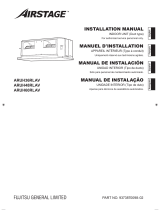
En-1
1. SAFETY PRECAUTIONS
Contents
1. SAFETY PRECAUTIONS ..........................................................................1
1.1. IMPORTANT! Please read before starting..........................................1
1.2. SPECIAL PRECAUTIONS ..................................................................1
2. ABOUT THIS PRODUCT...........................................................................2
2.1. Precautions for using R410A refrigerant .............................................2
2.2. Special tools for R410A refrigerant .....................................................2
2.3. For authorized service personnel only. ...............................................3
2.4. Accessories ........................................................................................3
2.5. Cassette grille accessories .................................................................4
2.6. Optional parts .....................................................................................4
3. GENERAL SPECIFICATIONS ...................................................................4
3.1. Type of copper pipe and insulation material .......................................4
3.2. Additional materials required for installation .......................................4
3.3. Operating range ..................................................................................4
3.4. Electrical requirement ........................................................................5
4. INSTALLATION WORK .............................................................................5
4.1. Selecting the installation location .......................................................5
4.2. Installation dimensions .......................................................................5
4.3. Installation the unit ..............................................................................6
5. INSTALLING DRAIN PIPES ......................................................................7
6. PIPE INSTALLATION ................................................................................8
6.1. Selecting the pipe material .................................................................8
6.2. Pipe requirement ................................................................................8
6.3. Flare connection .................................................................................9
6.4. Installing heat insulation ...................................................................10
7. ELECTRICAL WIRING ............................................................................10
7.1. Wiring system diagram ..................................................................... 11
7.2. Connection cable preparation ........................................................... 11
7.3. Connection of wiring ......................................................................... 11
8. REMOTE CONTROLLER SETTING .......................................................12
8.1. Installing the remote controller .........................................................12
8.2. Setting the DIP switches ...................................................................13
9. CASSETTE GRILLE INSTALLATION ......................................................13
9.1. Remove the intake grille ...................................................................13
9.2. Install panel to unit ............................................................................14
9.3. Attach the intake grille ......................................................................14
10. FUNCTION SETTING ...........................................................................14
11. SPECIAL INSTALLATION METHODS ...................................................17
12. TEST RUN .............................................................................................18
13. OPTIONAL KIT INSTALLATION ............................................................18
14. CUSTOMER GUIDANCE ......................................................................18
15. ERROR CODES ....................................................................................19
INSTALLATION MANUAL
PART No. 9374318544-04
INDOOR UNIT (Compact cassette type)
1.1. IMPORTANT! Please read before starting
This air conditioning system meets strict safety and operating
standards.
As the installer or service person, it is an important part of
your job to install or service the system so it operates safely
and effi ciently.
For safe installation and trouble-free operation, you must:
• Carefully read this instruction booklet before beginning.
• Follow each installation or repair step exactly as shown.
• Observe all local, state, and national electrical codes.
• Pay close attention to all warning, and caution notices given
in this manual.
WARNING:
This symbol refers to a hazard or unsafe
practice which can result in severe personal
injury or death.
CAUTION:
This symbol refers to a hazard or unsafe
practice which can result in personal injury
and the potential for product or property
damage.
• Hazard alerting symbols
Electrical
Safety/alert
If Necessary, Get Help
These instructions are all you need for most installation sites
and maintenance conditions. If you require help for a special
problem, contact our sales/service outlet or your certified
dealer for additional instructions.
In Case of Improper Installation
The manufacturer shall in no way be responsible for improper
installation or maintenance service, including failure to follow
the instructions in this document.
1.2. SPECIAL PRECAUTIONS
When Wiring
ELECTRICAL SHOCK CAN CAUSE SEVERE PERSONAL
INJURY OR DEATH. ONLY A QUALIFIED, EXPERIENCED
ELECTRICIAN SHOULD ATTEMPT TO WIRE THIS SYSTEM.
• Do not supply power to the unit until all wiring and tubing
are completed or reconnected and checked.
• Highly dangerous electrical voltages are used in this sys-
tem. Carefully refer to the wiring diagram and these instruc-
tions when wiring. Improper connections and inadequate
earthing (grounding) can cause accidental injury or death.
• Earth (Ground) the unit following local electrical codes.
• Connect all wiring tightly. Loose wiring may cause overheat-
ing at connection points and a possible fi re hazard.
When Transporting
Be careful when picking up and moving the indoor and
outdoor units. Get a partner to help, and bend your knees
when lifting to reduce strain on your back. Sharp edges or thin
aluminium fi ns on the air conditioner can cut your fi ngers.
When Installing...
...In a Ceiling or Wall
Make sure the ceiling/wall is strong enough to hold the unit’s
weight. It may be necessary to construct a strong wood or
metal frame to provide added support.
...In a Room
Properly insulate any tubing run inside a room to prevent
“sweating” that can cause dripping and water damage to walls
and fl oors.
...In Moist or Uneven Locations
Use a raised concrete pad or concrete blocks to provide a
solid, level foundation for the outdoor unit. This prevents water
damage and abnormal vibration.
...In an Area with High Winds
Securely anchor the outdoor unit down with bolts and a metal
frame.
Provide a suitable air baffl e.




















